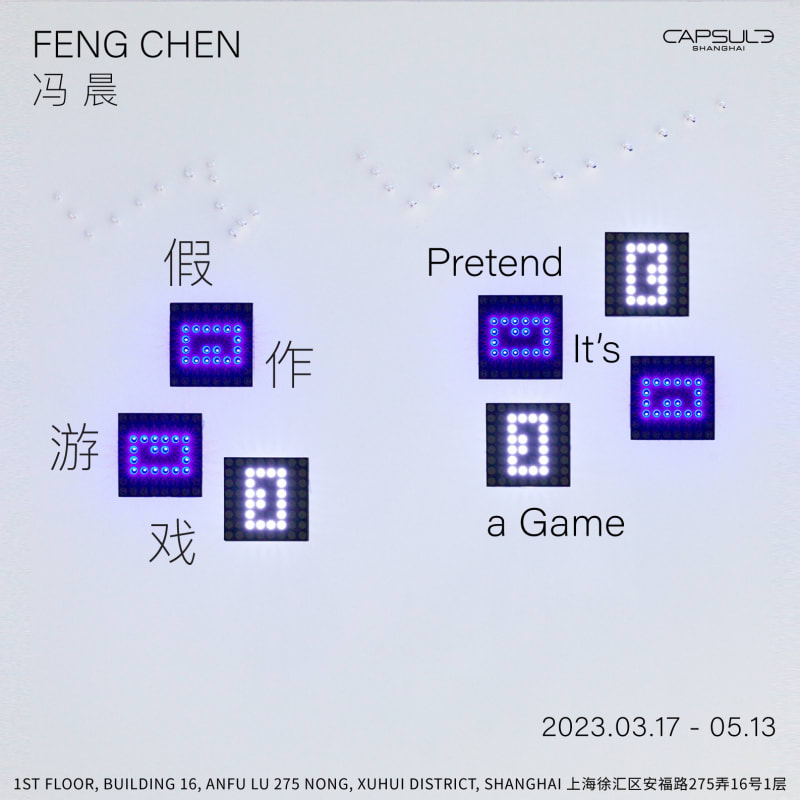Capsule Shanghai is pleased to present “Pretend It’s a Game”, Feng Chen’s (b. 1986, Wuhan, China) third solo exhibition with the gallery, which showcases his new carbon fiber three-dimensional drawings and interactive installations that expand his on-going investigation into the intricate relation between perception and reality. The show will be on view at Capsule Shanghai from March 17 to May 13, 2023.
Carbon fiber sculptures are a focal point of Feng Chen’s practice over the past several years, instigated by his interest in this material with an unprecedented combination of plasticity, lightness and solidity. The sculptures conceal their three-dimensionality and disguise themselves as lines drawn on the wall, only revealing their sculptural quality when the viewer moves around them and shifts perspective. While some are straightforwardly anthropomorphic in their forms that resemble human figures, others come to life when seen from certain angles, sketching various facial expressions or terrestrial creatures squirming forward, yet instantly resume their facets of modernist abstraction when the viewer changes position. In the same way that each twist of a kaleidoscope results in a different pattern consisting of the same pieces of colored glass, each step around the sculpture taken by the viewer conjures a unique optical effect – a game between the viewer and the work, the eye and the mind.
Humans often attempt to interpret and connect with the outside world through assigning our own images and qualities to inanimate objects. If the facial expressions in the sculptures emerge out of the viewer’s imagination as a result of pareidolia [1], the series of interactive installations titled Twinkles (2023) is a directly figurative representation of the face. Twinkling eyes open and move when a viewer’s presence is sensed in proximity to the work. When the viewer looks at its mirror-finished face embossed with noses, bangs and other facial features, they are inevitably confronted with their own reflection. When we look into the eyes of an electronical being and feel a connection, with whom are we empathizing?
Following the soft light in the eyes to the dim gallery room that features the wall and floor carbon fiber sculptures, the viewer is surprised by sound and light as their entrance awakens certain elements in the room: gaming sound effects synchronize with dancing flash from the spotlights on the ceiling, shining on the sinuous sculptures to cast flickering shadows. As one walks along the stanchions towards the French window and lay eyes upon the water sprouting from the fountain in the garden outside, the viewer might start to wonder whether these seemingly random activities follow the pattern of their own movement in the space. Will they detect the sensor that triggers the activities and find the key to interact with the machines?
The answer is secondary. When the viewer leaves the movement-activated installation, they enter the last room in the exhibition with a mirror on the wall, protected with another stanchion. As they approach the work, the mirror begins to bend, distorting their reflection. Here they may recollect the experience of visual and auditory senses in the previous room, and recall the title of the work – Pretend It’s a Game. The exhibition is as much an arcade as a labyrinth. The distorted figure in the mirror gazes back in taciturnity, suggesting that it is a game between one and one’s perception; the habitual link between the two is short-circuited by the artist’s deft orchestration of technologies and sensory experiences, allowing one to reexamine the misalignment between perception and reality.
[1] Pareidolia is the tendency for perception to impose a meaningful interpretation on a nebulous stimulus, usually visual, so that one sees an object, pattern, or meaning where there is none. - Wikipedia



